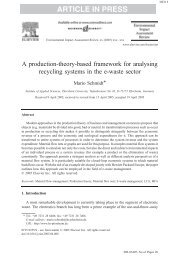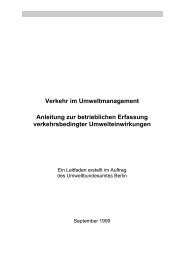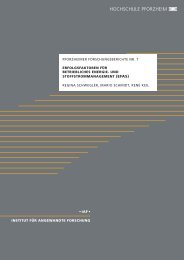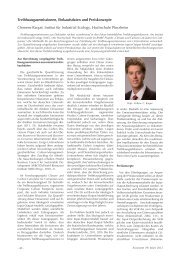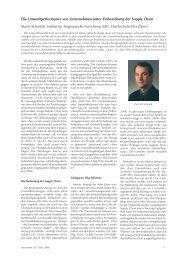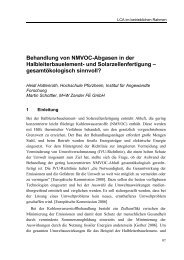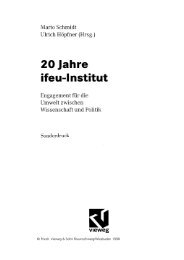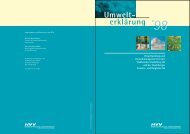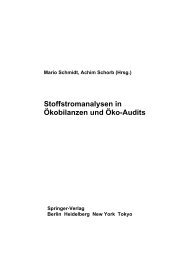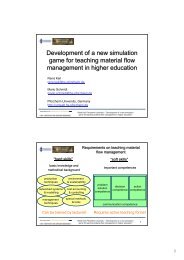Life Cycle Assessment of PET (Polyethylene Terephthalate) bottles ...
Life Cycle Assessment of PET (Polyethylene Terephthalate) bottles ...
Life Cycle Assessment of PET (Polyethylene Terephthalate) bottles ...
You also want an ePaper? Increase the reach of your titles
YUMPU automatically turns print PDFs into web optimized ePapers that Google loves.
Umberto <strong>of</strong>fers comfortable possible ways<br />
<strong>of</strong> describing complex product systems as<br />
material flow networks and process chains<br />
and <strong>of</strong> analysing the results (Schmidt et al.<br />
1997, Möller et al. 2000). The life cycles <strong>of</strong><br />
the systems are mapped as a material<br />
flow network which consists <strong>of</strong> up to 200<br />
individual process modules. Dealing with<br />
multiple product processes or difficult allocations,<br />
drawing up scenarios and conducting<br />
relevance analyses are facilitated<br />
by the s<strong>of</strong>tware. The material flows - broken<br />
down via various network levels - can<br />
be visualised as Sankey diagrams. The<br />
impact assessment is carried out on the<br />
basis <strong>of</strong> the input and output balance <strong>of</strong><br />
the systems and is partly distinguished by<br />
life cycle segments. This makes a sector<br />
analysis possible, i.e. the question as to<br />
which areas make the highest contribution<br />
to the relevant impact indicators can be<br />
answered.<br />
The final evaluation is based on two further<br />
steps. In a standardising step the results<br />
were presented on a different scale.<br />
For this the results <strong>of</strong> the LCA on the market<br />
potentially possible, i.e. on the entire<br />
market segment for mineral water and<br />
lemonades, were calculated for each impact<br />
indicator. Thus it was assumed that<br />
the entire market is serviced by the relevant<br />
packaging system. This would be the<br />
maximum influence which such a packaging<br />
system could exert on the relevant impact<br />
indicator in Germany. This value was<br />
set in relation to the overall value <strong>of</strong> an<br />
impact indicator in Germany and expressed<br />
in terms <strong>of</strong> population average<br />
values (PAV). In other words, a PAV value<br />
<strong>of</strong> e.g. 1000 for GWP means that the relevant<br />
system would contribute as a maximum<br />
just as much to GWP in Germany as<br />
1000 inhabitants if the entire market were<br />
equipped with the system.<br />
In a second step sensitivities were calculated<br />
in which variations <strong>of</strong> altogether 14<br />
system parameters or input data were examined<br />
for their impact on the results <strong>of</strong><br />
the impact analysis. The result <strong>of</strong> these<br />
sensitivity calculations was an optimised<br />
scenario, taking into account the currently<br />
realistic technical and economic general<br />
conditions. The conclusions for this study<br />
resulted from this.<br />
3 Results<br />
Figure 2 shows the graduated procedure<br />
on the basis <strong>of</strong> a calculated impact indicator,<br />
in this case the Global Warming Potential.<br />
The various systems for the stock<br />
purchase sector are first compared without<br />
the use <strong>of</strong> credits (cut-<strong>of</strong>f). Then the credits<br />
for secondary materials are taken into<br />
account (net), and finally the data are<br />
standardised as population average values,<br />
extrapolated to cover the entire market<br />
segment.<br />
This shows on the one hand the influence<br />
<strong>of</strong> the credit method used. It is pos-<br />
Figure 3: Contributions <strong>of</strong> the life cycle segments or processes to the Global Warming Potential<br />
in the two systems "Glass ret. 0.7 l C“ und "<strong>PET</strong> MR 1 l C“<br />
0.7 l Glass Returnable Bottle<br />
1.0 l <strong>PET</strong> Material Recycling Bottle<br />
200<br />
200<br />
<strong>PET</strong> recycling<br />
kg CO2 Equiv. per 1 000 l beverage<br />
150<br />
100<br />
50<br />
18%<br />
9%<br />
10% 11%<br />
33% 37%<br />
28% 31%<br />
Aluminium prod.<br />
Glass bottle prod.<br />
Distribution<br />
Filling / packing<br />
Cap/lid-prod.<br />
Other processes<br />
kg CO2 Equiv. per 1 000 l beverage<br />
150<br />
100<br />
50<br />
7%<br />
32%<br />
9%<br />
13%<br />
4% 5%<br />
34% 43%<br />
8% 10%<br />
6% 8%<br />
9% 11%<br />
<strong>PET</strong>(bottle grade) prod.<br />
Polypropylene prod.<br />
<strong>PET</strong> bottle prod.<br />
Distribution<br />
Filling / packing<br />
Other processes<br />
0<br />
7% 8%<br />
cut <strong>of</strong>f net<br />
0<br />
cut <strong>of</strong>f net<br />
6



